April 2008 – Cruising in Maui
Tuesday, April 1, 2008
Today we drove all the way around the island to to Wapia, Kona, Honkauka Harbor, on the Kona Coast, and just as night fell began driving the Saddle Road back to Hilo. It was an interesting exploration, and we were very impressed with the sheer girth of Mauna Kea, the biggest volcanic mountain on the island, and the biggest mountain in the world if measured from its base on the ocean floor. We hope to see more of the Kona Coast on Light Wave eventually.
Driving back on the Saddle Road, it was soon pitch black and we left most of the cars behind. We were on top of the world! And the stars literally filled the sky. Again it was very cold (thank goodness we had our sailing foulies with us), but I was peering out the window while Garett drove and saw the sky carpetted with stars, seemingly no space between, just stars radiating a heavenly light, so I made him stop three times to enjoy them. We got out, bundled in our jackets, leaned against the car, and just gazed and gazed. We felt like we could touch them, and tried to sense the infinite power of the Universe.
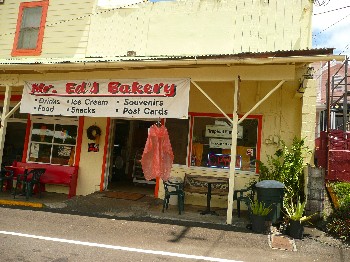
Just after leaving Hilo, we drove through a tiny town
called Papaikou, and stopped at this bakery
for great cinnamon buns.
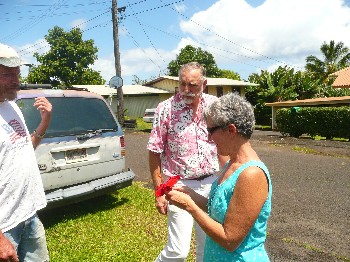
This is Ed, the baker, who invited us to his nearby
house, showed us all of his flowering bushes and
a little chamelion perched among the leaves of one,
gave me a hibiscus flower from one of his trees, and
told us that flowers are so prolific on the Big Island
that the locals take it as a compliment if you wear
one of theirs.
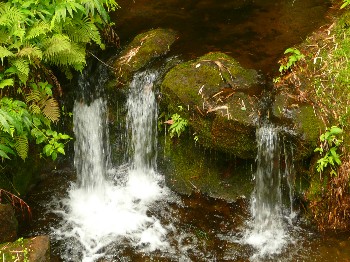
Miniature "falls" walking up the path to
Akaka Falls (about a foot high!)

Akaka Falls.
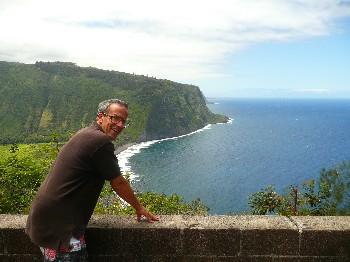
Waipio Valley lookout. We will be sailing by
this coastline in a couple of days, on our way north
then west to the leeward side of the island and the
Kona Coast.

Views of ranchland, an entirely different and much more
arid ecosystem, on the northern side of the island, and
the summit of Mauna Kea (13,796 feet).

A pretty young lady at the lookout. I (Carllie) told her
was very brave for sitting so calmly where she was sitting,
and she let me snap her picture.
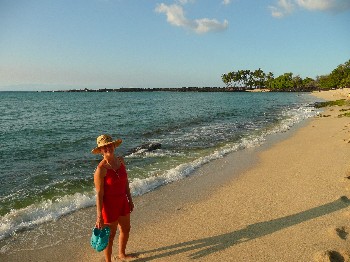
Going for our first swim in Hawai’i–we had to drive
our rental car across a very rough lava field, then walk about
20 minutes to get to this beach. Swimming was a bit of
a disappointment was the surf is so strong and lava rocks
on the bottom even as you wade out make swimming
in the surge a bit hazardous. Even wading out, Garett
scratched his foot pretty badly. However, the water was
lovely and surprisingly refreshing. Although it is sea water,
it is nowhere near as salty as the water in the Sea of Cortez,
and we did not feel we needed a shower afterwards!
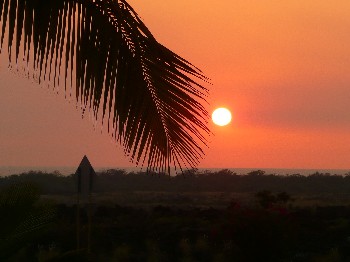
Sunset through the vog on the Kona Coast is
pretty spectacular.
Wednesday April 2, 2008
Carllie: We have arrived in Hawai’i, in Hilo on the Big Island, the island of chants, song, music, endless tracts of black toffee-like layers of volcano pitted with steaming reminders that the searing red flow lies just beneath the surface, and Pele in a feminine pique may erupt at any minute. Too many years ago when I visited this nation as an unfledged young woman excited to buy jewelry, get brown on the beach, and dine in glamorous hotel restaurants, I had little understanding of the depth of Hawai’i, nor of its true beauty. Even then in my uncouth youth the flowers impressed me, and today a mug full of gardenia blossoms in the cuddy cabin fills the air with a scent I still associate with that time in my life; hwoever, I had no inkling of the depth and beauty of the people of Hawai’i, based on their ancient culture and understanding of life.
We attended the first night of the annual Merrie Monarch festival, a week-long event when many different dancing troupes perform, as well as 12 hula dancers competing for the coveted recognition of Miss Aloha Hula. Contestants are all shapes and sizes, but they have a couple of things in common: an intense respect and love for Hawai’i and its culture, and beautiful smiles. True hula conveys a love from within, and the dancers seem to glow with that power.
We watched several different troupes perform, including surprisingly a large Mexican contingent, and all of the Hawai’ian groups were accompanied by extremely melodic chanting that seems to come from deep within, and singing full of resonant falsetto variations and modulations that also appear to more completely utilize the human vocal chords and draw a melodic resonance of sound from deep within. The event starts with everyone standing to the singing of the American anthem and the Hawai’ian anthem. We heard very few voices join in with the beautiful rendition of “Oh say, can you see?” but were delighted to hear a group of young Hawai’ian teenage girls behind us sing the Hawai’ian song, in Hawai’ian. The respect in their voices was evident and beautiful to hear, though their ear-piercing screaming during a series of dances performed by the first troupe accompanied, it turns out, by the beautiful chanting and falsetto singing of one of their grandmothers, was a little hard to take! After these songs, the audience continued to stand for the entrance of the “Royal Family” who are slowly shown to their places by an old Hawai’ian man dressed in traditional costume, chanting as he lead them slowly to their thrones. This family is not of course of the original lineage, but volunteer each year to fill these roles, and do so with great respect and solemnity.
Everywhere, we have been met with kindness, “Aloha!” and warm smiles. One day in our mad scurry around the island when we rented a car and were stopped in a gas station to fuel up, Garett dropped a wallet full of change at a gas station. While I teased him, a teenage boy jumped out of a car and helped him pick it all up. I was amazed. It is doubtful that this would have occurred anywhere in continental U.S.A. or in Canada.
In fact, Hawai’i does not feel at all like the U.S.A. It remains the Kingdom of Hawai’i, populated by a people who have regained an identity that was stolen from them by missionaries and arrogant bureaucrats, and they are slowly discovering the depth and beauty of their heritage. There is far more here than even most Hawai’i’ans realize, we believe.
We are glad we started our exploration of the Hawai’ian Islands with the Big Island, which we think may be more natural than the other islands. It has shown us what to look for, in any case.
Even Hilo, deemed the wettest city in the U.S.A., has stolen our hearts. Each of the first 3 or 4 days of our stay, Light Wave received thorough baths when the sky opened up with morning deluges, and we are collecting that clear pure water to fill our water tanks. However, returning each evening after a day of exploration, we usually found Light Wave dry and fresh as the afternoon sun had broken through, thankfully for our solar panels! Hilo is a small town and the downtown area consists of a scant six square blocks. We have loved the Farmer’s Market, which is supposed to be only on Wednesdays and Sundays, but always offers fresh produce. The vegetables and fruit grown on the Big Island are amazingly full of flavor, because the soil so recently produced by volcanic flows is black and rich. In fact this whole eastern side of the island, where the rain clouds drop their bounty, is lush and green. Driving around the island the other day, we caught sight of many areas between hillsides where the thick dense growth filled with spots of color of flowers spilled out. Beside the long roads leading to Volcano National Park and the other active volcanoes we visited, the growth of trees and bushes was so dense as to be impenetrable.
Back to the fruit and vegetables: we thought we had it good in Mexico with the big papayas we could usually buy for very few “coconuts.” In Hilo at the Farmer’s Market we buy Rainbow Papaya, small papaya full of a flavor that has to be the best we have tasted, five for $2! So we are still living in the lap of luxury, eating a whole papaya each for breakfast. We also get huge, extremely delicious avocado for $2 each, and I make can make two days worth of sandwiches (4 big sandwiches) with one. The salad greens and small tomatoes are amazingly full of flavor, and I have made many stir-fries with fresh out of the ground garlic (lots of it), Japanese eggplant, green beans, and even fern greens, stir fried in olive oil, sesame oil, and grated fresh ginger with a few dashes of soy sauce. (I still find it bewildering why people have such a hard time knowing what to feed vegetarians!)
As of today, April 5th, there are still many places we have not yet explored, and there will be many when we leave this island. This is fine, because we have more reasons to return! (A small Quid Pro Quo: NOT by boat!!!)
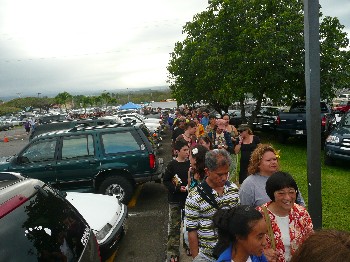
Folks on their way to line up for the
47th annual Merrie Monarch Hula
festival. A huge lineup!
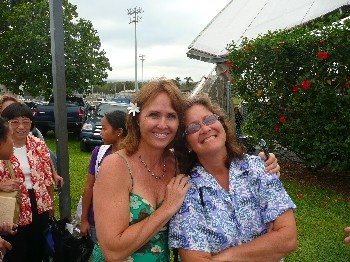
We met Keala (left) and her friend while in
the lineup. We got there just after 3:30 and
waited until 5 p.m. to get in, then another
hour for the show to start. It was worth it.
The first day is free, which shows a respect
for the people of the Island, as the next
three days are sold out as soon as the tickets
come on the market in January.

The crowd buzzes with excitement in the open-air
stadium (both ends are open letting a lovely cooling
breeze through) waiting for the show
to start.

A group of young Hawai’i’an boys blow
conch shells to welcome the "Royal Family"
to the commencement of the festival.
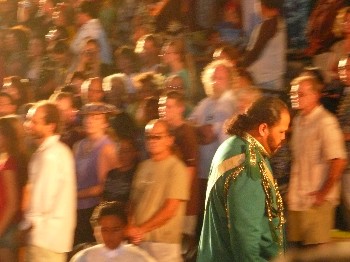
The "King" takes his throne.
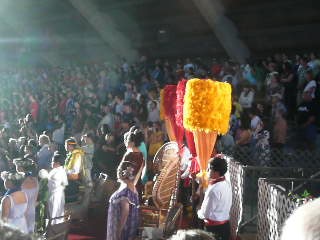
The seating area for the Royal Family
was close to us.
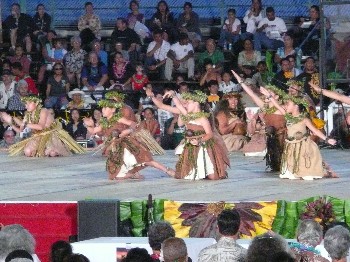
The first troupe of Hawai’i’ans in traditional
costumes that they make with natural fibres
performed for at least half an hour, to resonant
falsetto singing and chanting in the
Hawai’i’an language.
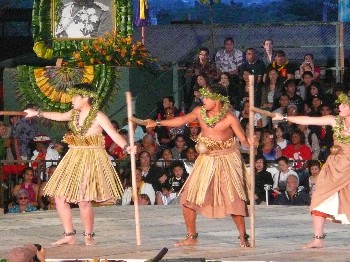
The same group–their dances were a particular type which is
very active and fast-moving. Their coordination was perfect
and their skills remarkable. We had never seen any hula
dancing like this, and feel very lucky to have arrived in
Hawai’i when we did.

The Mexican troupe performed in their very colorful
Mexican costumes for about an hour, going through
many different traditional Mexican dances, like those
we saw on the night of Dia de Independicia back in
Guaymas in September. They were very well received
by this Hawai’i’ an audience, who treated them with
much respect and great applause. The history of Mexico and
Hawai’i goes back to the early 19th century, when
Mexican gauchos came to the Big Island to
teach Hawai’ians how to be cowboys. They influenced
the music and the culture, and won the respect of
the Hawai’i’ans. The native history of Mexico resembles
Hawai’i in the way the people were dominated
by missionaries and bureaucrats, and in Mexico’s
case, slaughtered and enslaved by the Spanish.
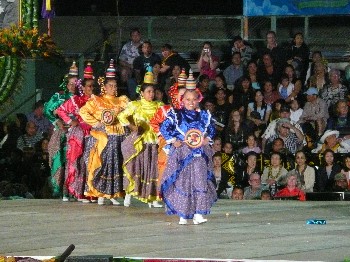
The Mexican troupe in another set of
beautiful costumes.
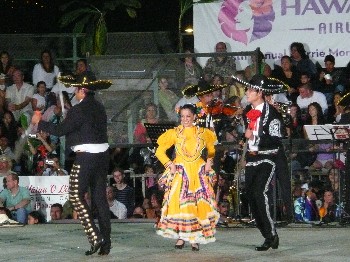
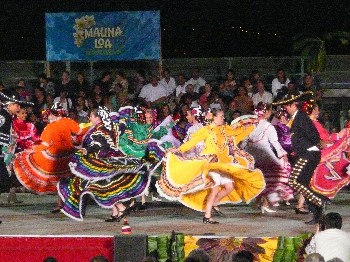
The dresses were so colorful with huge circular skirts that
the
ladies twirled to create vivid patterns of color.
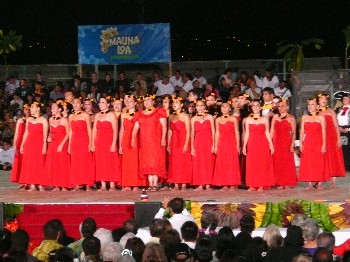
The Mexican troupe surprised and delighted their
Hawai’i’an hosts with their final number, a beautiful
traditional hula performed in these scarlet dresses.
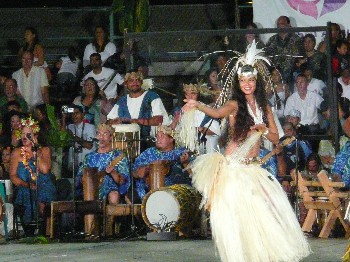
A Tahatitian troupe performed next, amazing
and delighting the audience with their hip-swivelling
expertise. (How do they DO that?? I kept going at it
when we got home, and the next day, "Boom, da-da, boom,
da-dah, Boom!" but I can’t quite figure out how to get
that neat swivel in my hips. Maybe I should take
lessons. No wonder these girls are so slim!
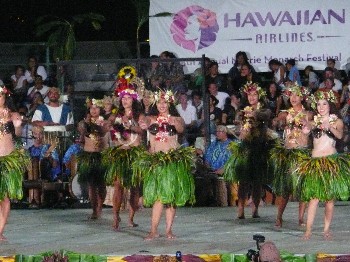
Tahitians sailed to Hawai’i centuries
ago, following those who first arrived in Hawai’i,
believed to be from the Marquesas Islands.
Thursday April 3, 2008
Garett: Today I worked on getting our engine put back together. I had a part sent from Vancouver by FedEx from my squash friend, Ian Binstead from Galleon Marine in Richmond, and so I cleaned up all the corrosion from where the wires shorted out and the electrolysis had eaten away the aluminum engine casing and starter relay.
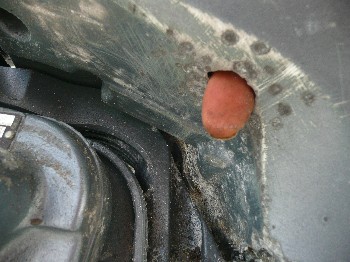
One-inch hole in the casing from electrolysis. (That’s
Garett’s finger sticking through he hole.)
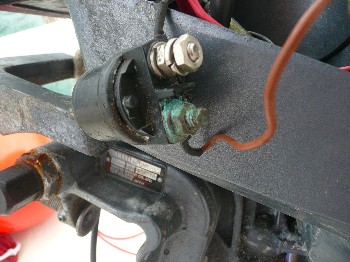
Corroded and shorted-out solenoid.
Garett did a great job re-wiring the engine and installing a new solenoid, and lubricating everything. We were delighted to find that the engine now sounds better than ever before, and starts instantly.
Friday April 4, 2008
Carllie: Today, we took the free cruise ship bus up the hill to the Imiloa Astronomy Centre of Hawai’i, and enjoyed a long show in their 4-D theatre called Man In Space, about man’ exploration of space since the first Russian orbiting of the Earth in 1961. It was interesting, but we enjoyed more the guided tour through the stars after that show, when the lively narrator showed us various constellations and told us their stories. Here we also listened to several automated recordings explaining the history of Hawai’ian chants and music, including the invention here of the steel guitar, which eventually branched off to become today’s electric guitar. The Hawai’ian steel guitar, however, is still played in the harmonious traditional melodic manner. We learned that in the late 19th century American bureaucrats who were basically governing the island outlawed the speaking of the Hawai’ian language because "it wasn’t good for them." Since the late 1970’s, the Hawai’ian people have reclaimed their heritage, in their language, their chants and singing, and to a certain extent in their original understanding of life.

Photo of some Hawai’ians in the early 20th century.

This charming older Chinese couple, Susan and Chen,
offered us a ride back from Imiloa–very very kind as it
would have been about a three–mile walk, though downhill!
Saturday April 5, 2008
Today, we walked into town (about 3 miles) to watch the Merrie Monarch parade. It was very colorful–full of Hawai’ian flowers of all types and colors.
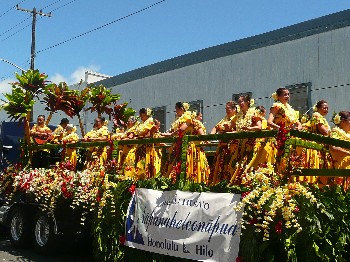
One of the floats in the parade.
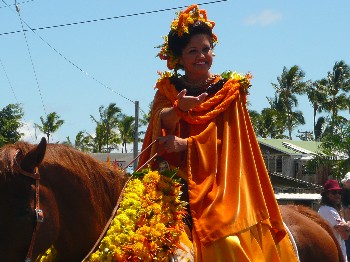
One of the "princesses" seated on a horse
wreathed in leis, as were all of the horses.

Another princess, from one of the other
islands.
Many of their "princesses" were somewhat aged!
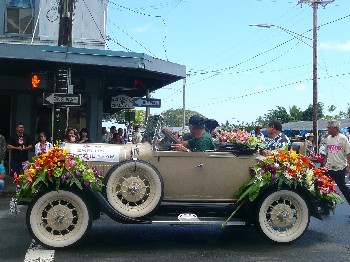
Many different people and groups participate
in the parade, which lasts a couple of hours.

It was great fun standing with local people
enjoying all the different participants.
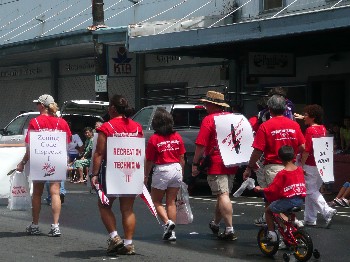
This was a group of workers from the City or State, and
each person carried a big placard saying what his/her
job is!
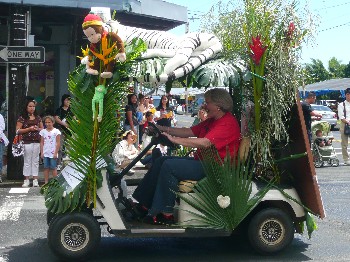
There is no shortage of greenery and flowers here.
One person told me there are so many flowers on this
wetter side of the island, that the islanders will thank
you for wearing their flowers!
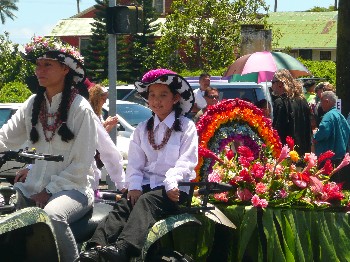
Many young people, even little children,
participate in the parade.

Big smiles and gracious waves…
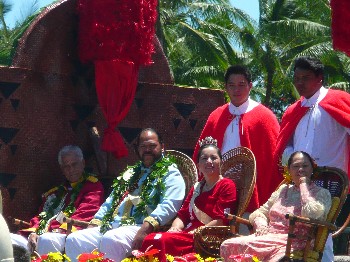
The "Royal Family" goes by on their float.
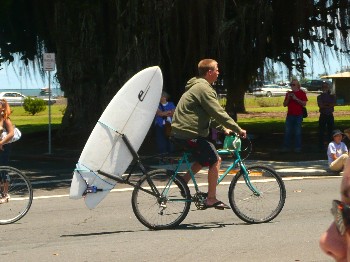
This guy wasn’t in the parade, but Garett had to
snap him with his surfboard on his bike! Garett
is scheming to learn how to surf!
Tuesday April 8, 2008 – Last (almost) Day in Hilo
Garett: Many locals had told us we had to go to Ken’s Pancake House in Hilo for the Macadamia Nut Pancakes, so finally today was the day. This restaurant had received the award for best pancakes in the USA as well as one of the 10 best breakfast places. It really lived up to its billing and we had leftovers to take home for late night desert. (C: The pancakes were fluffy, chock-full of macadamia nuts, sprinkled with macadamian nuts, and we had them with the scrumptious Lili’uokalani Syrup, made with passion fruit. Yum yum yum.)
Ken’s is half-way on the 3-mile walk to downtown Hilo. We then stopped at the hardware store and got a deal on a package of 80 earplugs for the crossing back to Vancouver. (C: Now what does that tell you novices about crossing the ocean in a small boat?) We continued to burn off breakfast as we walked to the internet cafe where we uploaded the files for our April 8 web update (C: at a whopping $9/hr compared to $2/hr in Mexico or free whenever our WiFi can pick up an unsecured internet from the boat!) and then we went down to the Farmer’s Market where we picked up a supply of more great local produce. The best deal was 5 papaya for a $1 – wish we could get these in Vancouver. (C: These are small papaya called "Rainbow Papaya" and are the most delicious we have ever tasted!) We then went to the KTA grocery store where I picked up some dry goods while Carllie waited out in the parking lot with our bags of produce. By the time I got out she had med a lady who happened to drive a taxi and so we got a lift back to the boat while a thunder and lightning storm started around us.
Our plan was to leave at dawn the next morning for the 70 mile trip around the north end of the island to Nishimura Bay, our jumping off spot to cross the Alenuihana Channel to Maui. By the time we had dinner it was dark and we still had to do our laundry and fill up our tanks with water. By now it was pouring rain. While Carllie stayed with the laundry in the laundromat, I loaded up most of our water jugs and dinghied over to the breakwater. It was now 9 p.m. and still raining steadily. I was wearing my foul weather jacket, but by the time I had the 40 gallons back on board I was thoroughly soaked but still had to go pick up Carllie at the laundromat a half-mile from the harbor.
It was 11 p.m. by the time we were back on board putting everything away for our early morning departure when it ***really*** started to rain with continuous thunder and lightning until 3 a.m. in the morning. It rained so much that I started dumping out the city water I just got from the dock and filling the jugs with the beautiful sweet rain water. By 3 a.m. I had collected 40 gallons and had refilled all the water jugs again!
The weather seemed unsettled so we decided to wait one more day in Hilo.
Wednesday April 9, 2008

I try my hand at using up the yams we
had on board since Mexico with a
recipe from my "Quick Breads" book.
Thinking I was pretty smart, I added
some macadamia nuts. However, failed
to realize that you need "unsalted" nuts
for the recipe. So it wasn’t as yummy as
it looks.
Thursday April 10, 2008
Garett: We were up at 4:30 a.m. and had the anchor up by 5:45 as the sky slowly lightened. We quietly motored out of Radio Bay past our three neighbouring cruising boats, along the inside of the two-mile breakwater and then made the right hand turn out into the 6 foot swells that had been marching for 2500 miles across the Pacific. There was no wind as we made our way north and we could see a cruise ship about 4 miles off getting ready to make a stop at Hilo.

Dawn as we make our way back into the Pacific Ocean
from our snug harbor at Hilo.
For the next 2 hours showers came by to douse us and finally by 9 a.m. we were to sail.We had 70 mile to cover in just 13 hours so we had to average 5.5 knots. By noon we were making good time as we followed the coast north just 3-miles form the beach. The hillside slowly rose to Mauna Kea in the background.

Majestic Mauna Kea, rarely visible, pokes
her head out of the clouds in the early morning
as we leave Hawaii.
We turned the corner around northern corner. The winds were really whistling as we entered the east end of Alenuihana Channel but we were sailing downwind in flat seas the last 7 miles to Nishimura Bay.

Wind generators on the north end of Hawaii.

Our first "heiau", said by current archaeologists
to be a navigational marker but who knows?
It is like a small Stone Henge.
We actually made it 30 minutes before sunset and after anchoring in the relative calm of the bay we could see that the water was crystal clear so we went for a quick swim and snorkel. Even in the fading light I could see the bottom 30 feet down. It is too bad we had to be off in the morning as the snorkeling along the shore looked very interesting.
Carllie: We left Hilo and sailed 70 miles to the northwest tip, anchoring for the night at a tiny bay called Nishimura Bay by the locals. Just above a rock wall created by a now defunct railroad company, there is a heiau, a sacred site for Ancient Hawaiians, which present day archaeologists consider to be a navigational marker, but who can say for sure? It is like a mini Stonehenge, and one cruiser (as reported in our cruising guide) who has visited it many times, always gets "chicken skin" there. I have a feeling it is far more than a navigational marker. As soon as we anchored, we jumped into our swimsuits and went for a swim and snorkel around the boat in beautiful crystal clear turquoise-blue water. Once we had fresh-water showered afterwards Garett noticed this faint buzzing in his ears, and when I listened so did I. I am wondering if it has something to do with the circle of stones…
After 12 days at anchor at Hilo, I had forgotten about my propensity for seasickness in big swells, and so had not prepared myself with Transderm Scop for the open ocean, with foregone conclusion–I was seasick most of the way… Sigh. What a bore!
Friday April 11, 2008

Taking off into the boisterous Alenuihana Channel.
This was before things got REALLY wet.
Carllie: This morning we left Nishimura Bay early
(much to my regret as I wanted to stay another night and go to shore for a walk
to the circle of stones), so we could cross the infamously treacherous Alenuihana
Channel between Hawaii and Maui early, to avoid the build up of wind. Well,
the wind built up very fast and soon waves were crashing at our beam, spraying
water over the whole boat. However, we were doing 7 to 8 knots, so we kept ahead
of things. My tummy wasn’t quite up to it, and Garett wanted to keep on eye
on things as it was pretty fast sailing, so he stayed outside the whole time
from when we left at 5:50 a.m. to our arrival on the Maui side at 11:30, and
then until we finally stopped to anchor at Kihei at 3:00 pm. I made a quick
lunch, and he is now down in our sleeping hull dead to the world.
This is a pretty open roadstead type anchorage, so we will be bouncing around
a bit, but we are pretty sure it’s safe for the night.
Garett: We were up again at 5 a.m. for the 35 crossing of Alenuihana Channel between the Big Island and Maui. This is reputed to be the worst of the Hawaiian channels and perhaps even of the world. We were advised to pick a calm day (which was forecasted) and leave early (we did).
Within a half mile of pulling up the anchor we were sailing at 6 knots with full main and jib. Shortly thereafter I reefed the main, and then a few minutes later took the whole main down. We were just sailing with the jib and making 6 to 8 knots in building short steep waves and winds of 25+ knots.
When we got to the 18-mile halfway mark I thought it might start easing up but noooo it got worse. I stayed outside in the cockpit getting soaked when the big waves hit the starboard side and exploded in a torrent of spray. Fortunately it was sunny and though I got wet it was rather exhilarating.

A very game skipper gets very soaked
while we crossed Alenuihana Channel.
Finally in the last mile as we approached La Perouse Bay on Maui, the winds lessened to 20 knots and the seas flattened out. It was an interesting crossing but I sure wouldn’t want to be our there when the trade winds were strong. This was supposed to be a day of only 10-15 knots of "light trades." I guess the rough water is caused by the funneling effect of the mountains of the islands.

Our first of Maui and the extinct volcano of Haleakala.
Saturday April 12, 2008
We anchored at the far northern end of Ma’alaea Bay last night protecting us from the northern winds. Yesterday was a long day so we decided to take it easy and go for a little walk on the beach and explore the local area.

Outrigger canoes paddle by Light Wave
anchored at Kihei.

This friendly fellow paddled his surfboard
past Light Wave. He had the board custom
made because he is a little hefty.

Hawaiian children playing on beach
at Kihei.

Walking the beach at Kihei.
Sunday April 13, 2008
We stayed one more windy day at anchor at Kihei. Eventhough we were protected form the waves the wind whistled. We later learned that this is one of the windiest places on the Hawaiian islands.

Views from our anchorage at Kihei.

Wind blows hard.

Monday April 14, 2008
Garett: After three nights at Kihei it was time to get out of the wind so we headed off the 20 miles west to Lahaina.

Anchored at the very rolly "anchorage"
off Lahaina.

Carllie: First view of Lahaina, a town I remembered
fondly from my first and last visit to Hawaii
in 1977! It is much changed, and not so
charming as it then was.

Big swells going by Light Wave swallow
her up, making her look smaller than
she is.

Walking the beach walk at Lahaina.

Jewelry stores abound in Lahaina, and
apparently in all of Hawaii.

Night view of Front Street,
Lahaina.

Sunset from rolling anchorage
at Lahaina.
Tuesday April 15, 2008
Carllie: We are now anchored off Lahaina on Maui, arrived yesterday
afternoon. It was very rolly here yesterday as there was a south wind and the
swells were coming in. I had been a tad "woozy" the whole way from
Kihei to Lahaina–not much fun or good companionship for Garett.
Lahaina has changed so much since I was first and last here 30 years ago. Well,
I guess it would. Whereas then it was a charming, a little rundown, old whaling
town with funky little shops, now it is all polished and swarming, literally
swarming, with tourists who ignore you as you walk by, "protect" their
children from the smiles and kindness of strangers, and continue walking past
you in a huge non-stop line preventing you from following your husband into
a store. I guess I should feel sorry from them, as I know that they are squeezing
their vacation into one or two weeks, and I can see the driven, discontented
looks in their faces. But it’s tough. The Big Island was so much nicer, so much
more natural. The people were not "dressed in the latest sexy clothes,"
and wore more natural clothes, by and large. The whole feeling of the place
was different.
Anyway …I am hoping that we will find more secure anchorages in secluded spots
where we can get back into nature. Garett assures me we will. However, cruising
in Hawaii is far different than in the Sea of Cortez as of course it is wide
open to the ocean, and in fact at present it seems there are few really protected
spots unless, as at Hilo, you are in a man-made harbor protected by breakwaters.
It is hot already–80 degrees–and climbing! And of course there is less rain
on this island than on the rainy side of the Big Island, so the skies are more
or less clear. We will be going to shore again this morning to pay for our mooring
ball and take showers, then maybe try a little run and walk, and shower again!

Pretty views from Lahaina.

Getting ready to enjoy our first
mahi mahi burger at the Lahaina Yacht Club,
note Light Wave at anchor in the background!

The biggest banyan tree in the world,
in Lahaina.

Artists and artisans abound in Hawaii.

Very wary cat, during one of our walks.
He should try living in Mexico!
At least he gets fed, and he is not pursued
by boatyard dogs!
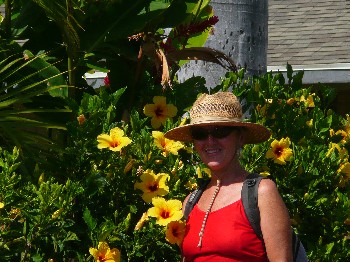
Hibiscus flowers, plumeria, and pikake abound
I love all these flowers!.

Looks peaceful, but the anchorage is very rolly…
Wednesday April 16, 2008
Garett: We let go of our mooring ball and motored north to head to Black Rock off the Kanipali coast to do some snorkeling, on our way to Moloka’i and Lanai to scout out anchorages to visit with Casey and Amandah, who will soon be arriving. One mile further down, still in Lahaina, is what is called the Mala Wharf anchorage, and we stopped and set our anchor just to check it out. Wow what a difference! Hardly any swells! This is where we are going to return to anchor after our scouting trip, so we can pick up Casey and Amandah as the Lahaina open roadstead is too scary.
We headed north across the channel to Moloka’i We were trying to find the unmarked reef entrance to Puko’o anchorage. Fortunately the GPS coordinates we had were quite accurate (and the GPS chart is accurate, because, unlike in Mexico, the navigational charts are very accurate) but it was still a little scary sailing into a 100 yard opening in the reef, with surf breaking on the reef, roaring and frothing on both sides.

Sailing to Moloka’i from Maui.

Our first entrance through a surf-strewn reef
was a little hairy!

Safely anchored in beautiful Puko’o
on Moloka’i. Peace at last!

A local Hawaiian stands on the reef (so much for
protecting the coral) to fish. We later learned huge
reef sharks live under the ledges of these reefs. Hah!
Doesn’t this guy know about them?
Maybe he was a lot taller when
he first started fishing???

Sunset from Puko’o.
Thursday April 17, 2008
Garett: After a peaceful sleep in our protected spot completely encircled by the barrier reef we took the dinghy ashore and walked to the small store, then back up the road a ways where we saw nice little houses and a few very pretty "designer" houses. A lovely, quiet place, Moloka’i. Far more tranquil than Maui.

Local resident doing some fishing
in the calm behind the reef.

Finally, some remote jungle.

Huge 1-inch bumble bees that really buzzzz.

Light Wave protected behind the reef.
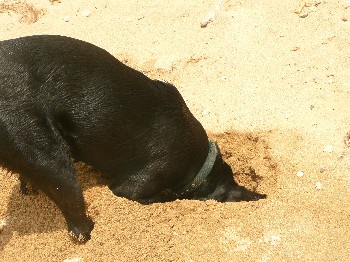
We found this local dog that was obsessed with digging
down to find the ghost crabs on the beach. He
was very entertaining and adopted
us for quite a while before we
told him he had to go home.

Dramatic hillside of eastern Moloka’i
Carllie: It was great to finally be in a remote anchorage, fully protected by the reefs, natural breakwaters, where we could enjoy swimming, snorkeling and walking in peace.
Some Background on Moloka’i
Carllie: It is unfortunate that most people think of leprosy when they think of Moloka’i, ourselves included until we began reading about the island in our cruising guide and Lonely Planet books. In fact, today it is known as the “friendly isle,” and the people (over 50% of whom are pure Hawaiian or can trace their lineage back to ancient Hawaiians) are very friendly and welcoming, and there is far more here than meets the eye. Not to mention it being very beautiful.
From Cruising Guide to the Hawaiian
Islands by Carolyn and Bob Mehaffey:
“Early Hawaiians called the island Moloka’i nui a Hina (‘great
Moloka’i land of Hina’) and Moloka’i pule o’o (‘Moloka’i
of the potent prayer’). Both names refer to the spiritualism and sorcery
the Hawaiians ascribed to this island. The island was a place of refuge for
those who broke the kapu [ed. note: these were the strict tabus enforced by
the ancient Hawaiians] on any of the islands, for the mana (‘divine power’)
of its kahuna (‘priests, sorcerers’ [ed. note: so called by the
Mehaffeys and their reference sources]) was the oldest, strongest, and most
respected throughout the islands. Kamehameha I was but one of the powerful leaders
throughout Hawaiian history who relied on the power of the kahuna of Moloka’i.”
Interestingly, the Mehaffys also note that the early residents were legendary athletes known for their quickness, and the first hula dancers were from Moloka’i. They note, “While the dance itself is physical, it was, and, for some Islanders, still is, an entirely spiritual activity, and its legendary origin on this most spiritual of islands seems natural.”
As we we later note in this log update, there are numerous heiaus (sacred sites) all over the island, and we theorize that these heiaus were possibly centres of conscious mental energy.
Regarding leprosy, in 1835 doctors diagnosed the state’s first case of leprosy, one of may diseases introduced by foreigners, and that that year Kamehameha V signed an act banishing people with leprosy to the Kalaupapa Peninsula, on the north side of the island. This peninsula is surrounded by the highest cliffs in the world and shark-infested waters, ensuring the unfortunate people could not escape. They were left to their own fate and were not cared for in those days, as everyone was so frightened that the horrible disease was contagious that the patients were literally dumped off the boats who delivered them, and no one cared for them. Finally in 1873 a humanitarian Belgian priest, Father Damien, arrived and stayed to care for the people and give them a sense of hope. According to the Lonely Planet: Hawaii, some 8,000 people lived out their lives on the Kalaupapa Peninsula. In 1873 Dr. Gerhard Hansen discovered the bacteria that causes the disease was not hereditary, and proved that it was one of the least contagious of all communicable diseases. It then became known as “Hansen’s disease,” although those who have suffered with it prefer to call it leprosy because they feel that this new name fails to reflect the stigma they have suffered. Since the 1940s sulfa antibiotics have been successfully used to treat and control leprosy. However, it was not until 1969 that the isolation policies were abandoned. Although the patients were free to leave, many preferred to stay because it was now their home. Some 100 patients still live on the peninsula, most senior citizens. It is a protected area that requires a permit to enter, to protect the privacy of the people, and visitors are not allowed to photograph the people. The Lonely Planet states, “The degrading appellation ‘leper’…is offensive to all. ‘Patient’ is preferred.”
Since we arrived at Maui, we have sailed to Moloka’i three times, and all-tolled have spent almost two weeks at various anchorages here. We have snorkeled in the reefs, Garett has seen his first reef shark (more on this later!), as did Casey, and have gone to shore many times to enjoy the beautiful walks on the main road, mahi mahi burgers, the people, the birds and the flowers. Unfortunately, we will not be able to visit the north side of the island and see those spectacular huge cliffs due to wind and time constraints.
Friday April 18, 2008
We left early in the morning to head west hoping to anchor in Kamalo anchorage behind the reef but when we arrived it didn’t look or feel too appealing and so we continued onto the main harbor at the town of Kaunakakai.

Leaving Puko’o, looking for
our next safe anchorage.
When we arrived, anchored behind the long breakwater and set foot on shore we found out that it was "Earth Day," which is a really big here in Kaunakakai, the main town of Moloka’i
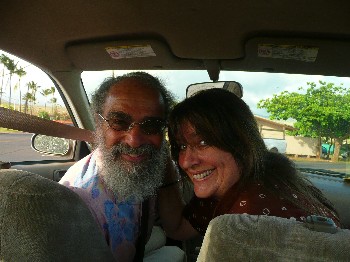
This nice couple gave us a lift the half mile to town.
Friendly folk abound on Moloka’i.

The whole town was out for this event.
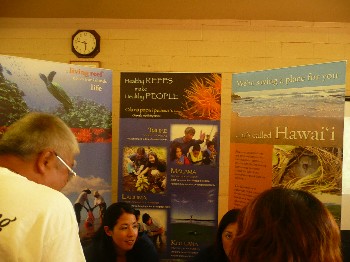
The community center had was full
of displays and booths.

This Hawaiian baby appears not to
like the music. Surprising, as all
Hawaiians love music!

Local school children sang many
traditional songs.
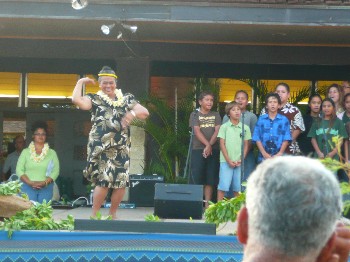
And some hula dancing by Auntie.
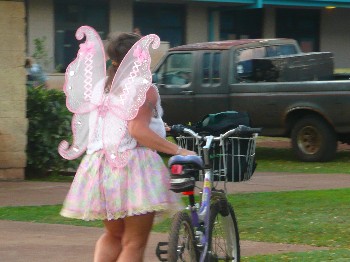
This lady even had her angel
wings on for the event.

Light Wave anchored. Note the blue shadow
above where the sun set. We see this
phenomena often here but have
never noticed up in B.C. waters
Saturday April 19, 2008
Garett: We actually made ourselves do some exercise today and ran 3 miles before we headed into the small Farmer’s Market. It was nothing compared to the one in Hilo, but we did get some local papaya and stuff.

Sunset at Kaunakakai.
Sunday April 20, 2008
Garett: We still had a few days to get back to Lahaina and so we headed off behind the wind shadow of Lana’i to make the circle back. We were kind of scoping out the route we where would take Amandah and Casey on next week.

Dawn at Kaunakakai.

When we left the anchorage it was calm but 2 miles
across the 10 mile channel the winds
were up to 20 knots+. As we approached Lana’i
it got even windier and the waves quickly
built to a very steep 10 feet
(probably because of current at the point).
We took a few waves into
the cockpit and we both got quite wet.

The winds finally abated in the wind
shadow of Lana’i and we enjoyed the scenery.
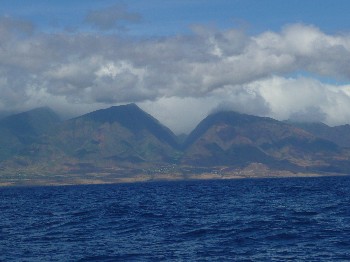
Finally returning back to Lahaina.

The backdrop to the Mala Wharf anchorage,
with a little rainbow over the hills
behind Lahaina.

A classic Hawaiian sunset from
Front Street in Lahaina.
Carllie: We just got back to Maui this afternoon, after spending
4 days at Moloka’i anchored at two very nice anchorages. We loved Moloka’i as
it, like the Big Island, is very natural and unaffected by the blight of developers’
money that has ruined the naturalness of much of Hawaii Walking from Mala Wharf
into the Lahaina town, then back, we came across a fellow selling freshly made
leis, and I got my first lovely plumeria lei!!! It smells wonderful!
Chuck, a continental American resident of Moloka’I who lives aboard his
boat, when I asked how to find a particular heiau (sacred place), said the island
is "full of them." Again thinking back to the heiau at Nishimura bay,
it may seem fanciful, but I cannot help but wonder if there is more here than
meets the eye.
We are getting ready to bring Casey and Amandah aboard when they arrive here on Wednesday. We are now anchored at Mala Wharf, an abandoned wharf about a mile from Lahaina town, where we actually have internet from the boat!
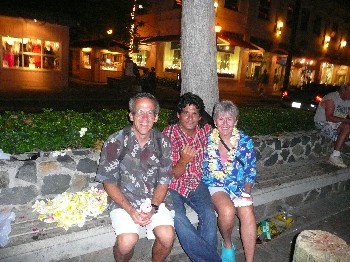
With the street vendor who made Carllie’s
first plumeria lei.

Carllie happy with her lei and not pining
for the jewelry.
Monday April 21, 2008
We had a spare day and so we took the bus to the Whaler’s Village at Kanapali.
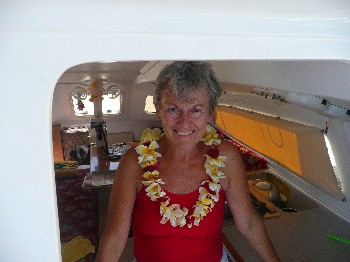
Carllie with her lei. It lasted a good
three days. Just lightly run some cool
water over it at night, shake it out
gently, then lay it in the fridge/cooler.

Our view to the north at Mala Wharf.

Jill and Howard who gave us some
good advice on diving with sharks.
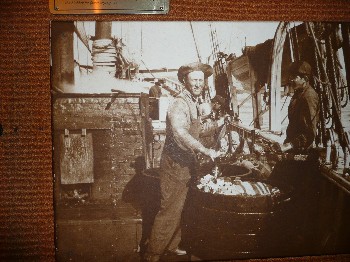
We really enjoyed the Whaler’s Museum.
Lots of incredible photos and informational
posters detailing the incredible hard
lives of the whalers, who went to sea for
four-year stints, sailing far into the icy
Arctic to follow and capture the whales
they sought.
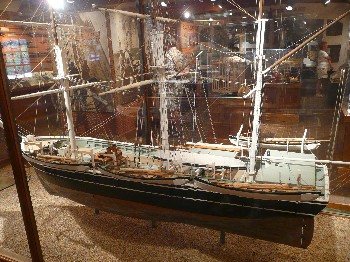
The exhibits are must-see.
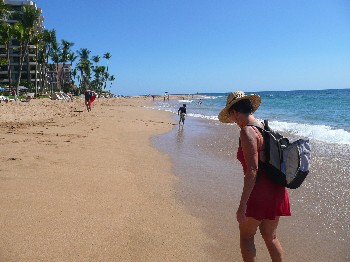
We even had time for a swim on the beach.
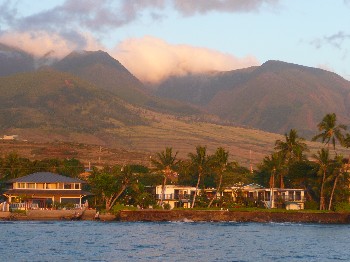
Back at the boat for a peaceful sunset
at Lahaina.

Time for ukulele practice. She bought
this beginner’s ukulele a few years
ago in Vancouver, and I bought her
a book to learn to play it in Hilo,
with the promise that if she learns
to play I will buy her a "real ukulele"
before we leave Hawaii.
Tuesday April 22, 2008
Garett: We spent most of today doing trips for laundry, gas, and shopping at Safeway and Foodland so we had the boat all stocked for Casey and Amandah’s arrival tomorrow. Carllie also cleaned the boat and tidied up their "living hull", which is normally our bedroom hull. We will sleep in the folded down double bed in the cuddy cabin.
Wednesday April 23, 2008
Garett: We were up at 6 a.m. to catch the bus to the Farmer’s Market about 10 miles up the coast.
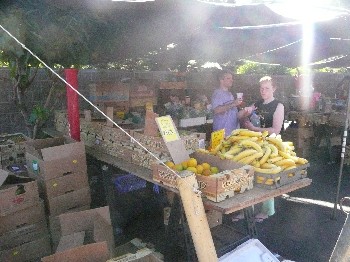
"Farmer’s Market" in Lahaina was
actually produce put outside by a
local grocery store, and was no where
near as good as Hilo, quality-wise or
price-wise. But we had
fun stocking up!
About a week earlier my long time squash friend, Dave Hall, from Vancouver had emailed that he would be over with his family to do some windsurfing with his wife Audra, also a squash player. We arranged to take Dave and his 4 -year old son Taylor out for the afternoon on Light Wave for some whale watching and swimming. Dave said he was going to write off the expenses for his Hawaiian holiday to our Division 1 Vancouver Racquets Club squash league team as a "recruiting trip" to get me to come out next year. I just want to confirm to everyone that I was successfully recruited and will be back and ready to play next September. How good my fitness will be is another question, maybe I will have to stoop to go for more winner’s shots than running, like I usually do.

Dave, Taylor and Garett.

We saw a lot of humpback whale families
–mama, baby and "escort male," and had some close
encounters to almost 50 feet.
We missed the pictures of those ones
because Carllie was so excited she
forgot to focus the camera!

Dave diving off the hardtop.

Son and dad swimming.
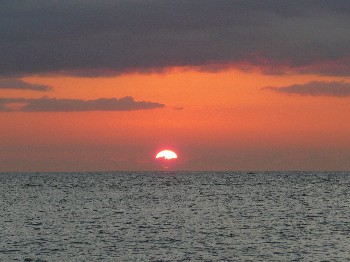
Another Maui sunset.
We were scheduled to go to shore at 7:30 p.m. to pickup Casey and Amandah. When we arrived on shore they were there waiting and had actually been there since 5 p.m. as there airline had cancelled their flight and had bumped them up to an earlier one. It was great to have our friends with us for 10-days of high adventure.
Thursday April 24, 2008
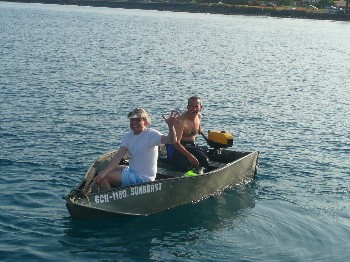
Casey and I headed out for some spear fishing
off Mala Wharf early in the morning.

While sailing with Casey and Amandah we
enjoyed many more encounters with
humpback whale families.
Mama, baby and escort whale.
Sometimes they were even breaching,
and a few times we were able to sail
quite close up to them. They are amazing
to watch, and we were so glad Casey
and Amandah were with us when
we had these close encounters.
We pulled up the anchor at Mala Wharf to head to Honolua Bay, a few miles down the coast of Maui, to snorkel and stay the night before heading over to Moloka’i.

After a great afternoon of snorkelling in
Honoloa Bay we were treated
to a spectacular vog sunset.
Friday April 25, 2008
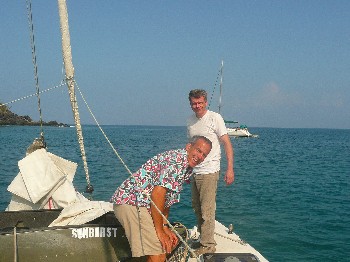
Pulling up the dinghy and
anchor, with much appreciated
help from Casey.
Carllie: Amandah is enjoying practising her photography with her beautiful Olympus SLR digital camera, which you can focus like a 35 mm, and she has gotten some amazing photos. At one snorkeling bay we went to, Honolua Bay on Maui, there is a surfing break at the entrance, where big waves break over reefs, and very experienced surfers come to surf. It is dangerous because of the waves breaking right over the reef, so they have to know what they are doing. Amandah got some great photos of the surfers. I even got one that isn’t too bad.
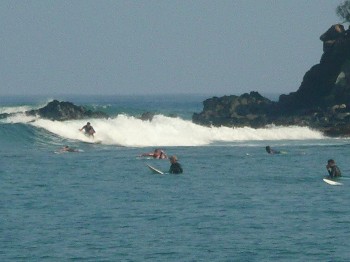
Surfers surf the break at Honolua Bay.
Garett: After Casey and Amandah’s first timer snorkel at Honolua Bay we motored in absolute flat calm seas across the channel to Moloka’i I warned our guests that the return trip would not be quite so smooth. C: We dropped our anchor at Puko’o, after again braving that scary entrance through the reef, and enjoyed seeing Casey and Amandah’s enchantment with the place matched our own.
Saturday April 26, 2008
Carllie: Today after delicious mahi mahi burgers from the food counter at the store, we walked to a heiau where Garett calculated there must have been a million lava stones stacked into this rectangular area about 200 feet long and 100 feet wide. To build it, the ancient Hawai’ians passed the stones hand to hand across the island from where the lava rocks were. Garett theorizes that these sites may be a centre of energy because everybody is focusing on one objective, to get all these rocks there, so maybe it becomes like a mental battery from all these thoughts because you would have to have several thousand people to do it, and probably each person handled a stone more than once. It’s one theory. Certainly there seems to be a protective energy around these islands. Where has it come from? Perhaps the so-called navigational marker heiau at Nishimura was built to ward off visitors with an unfriendly intent and to protect the islanders.
We are enjoying our time with Casey and Amandah, and after
a couple of days they seemed to be really enjoying themselves too. We have spent
two nights anchored at Puko’o on Moloka’i–a three-part small anchorage surrounded
by reefs that you have to negotiate to get into. This is our second time here,
so we already had our track on our GPS to follow, so it was less hair-raising.
Although there are a few houses along the shoreline, this is not a heavily populated
area, and some of these homes may only be occupied part-time. Plus there is
a public beach ashore so we can go to shore with the dinghy and enjoy walks.
We snorkeled the first full day we were here, to the nearby reefs, and Garett
and Casey snorkeled to more distant reefs. They both saw sharks, big reef sharks.
Both were over 6 feet, but the one Casey saw was even bigger emerge from under
a ledge he was swimming over. At first, Casey thought it was a big fish and
he got Garett’s spear gun all read to shoot it, then he thought, “Oh!
Really big fish.” Then he thought, “Uh-oh! Shark!” and exited
stage left. The sharks were just as surprised to see them as they were to see
the sharks, and I think both species went off in a different direction. However,
neither Casey nor Garett were anxious to return to the same areas. Casey, using
Garett’s spearfish for the first time, speared us a "goat fish" that
we shared for dinner. He’s pretty good with the spearfish because being brought
up in the far north he hunted and used a bow and arrow, so his hand-eye coordination
is very good. He caught the fish the first time out, and saw the shark when
he went back for more fish. He came back pretty fast…without a second fish!
Garett: A little earlier, I was snorkeling and spearfishing
with Casey in the murky waters along the reef edge with only about 15 feet of
visibility. Casey was just a little bit behind me when up ahead I could see
a big fish. As I got closer I realized it was a really big fish, make that a
shark. It lazily turned and swam into the murk. I turned to get Casey’s attention
but by the time he looked my way the shark was gone. Later we learned that it
was a "White Tipped Reef Shark." It did get my heart rate up, and
Casey says his encounter also got his pumper racing. Evidently these reef sharks
are quite shy and they avoid contact. I was lucky to see it only because of
the murky water.
Carllie: As a result of all this, I was just a tad uneasy when Amandah and I
were snorkeling over the reefs yesterday looking for small reef fish. The water
was still murky, and every time I swam over the ledge of the reef to the "drop
off" (only about 20-25 feet deep), I braced myself to possibly see a "really
big fish." Thankfully, I have not yet had my first heart-speeding-up sighting!
But the day will come. We met a very nice couple, Jill and Howard, at Mala Wharf
where we were anchored in Lahaina, who were divers and told us that there were
two resident reef sharks at the old falling-down wharf that now forms an artificial
reef at Mala Wharf. They had actually dived among reef sharks that had been
deliberately "chummed" (attracted by bits and huts of fish). They
assured us that these reef sharks will not bother us, and it is really a very
nice experience when they cruise by you, as they are "so majestic."
Hmmmm….I am still working on that concept.
We are just getting ready to pull up the anchor and have a quick downwind sail
to Kaunakakai, the main and only town of Moloka’i, where we will again anchor
inside the reefs off their big commercial dock for two nights. Then we will
decide (depending on the wind) whether we will sail back across the channel
or turn north and sail Casey and Amandah to Oahu, saving them airfare from Maui.
We crossed this channel back to Lana’i and then to Maui once already in a big
wind, and it was very rough. So we will see.
It’s great to have Casey and Amandah with us, and to know that they enjoy the
more natural, less populated, anchorages as much as we do, and that they don’t
need “tourist sights” and the busy-ness of more populated areas
to be happy and find joy in discovery and experiencing these islands.

Hiking on Moloka’i
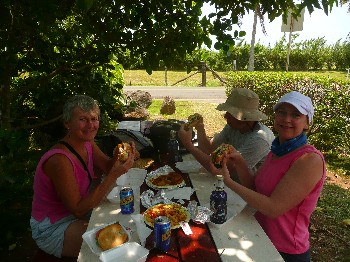
Mahi Mahi burgers from Mana’e Goods and
Grinz food counter near Puko’o.
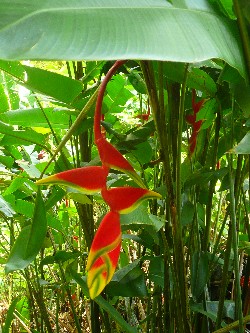
Exotic flower.

Heiau. I figure it would take several
months to build
this with about 5,000 people passing
the stones from the other end of the island..
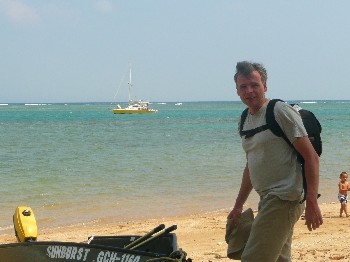
Heading back to Light Wave.
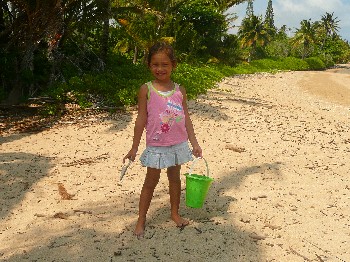
A darling keikei (child) on the
beach at Puko’o, who agreed to
pose for me. I think she said her
name was Kae’ae.
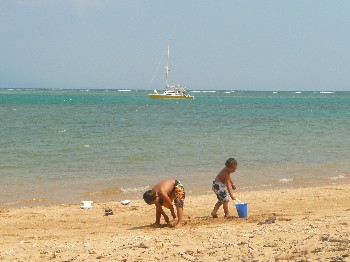
More Hawaiian children enjoying
the beach and water. Hawaiian
children are brought up in and
around the ocean and have no
fear of it. Note Light Wave waiting
patiently in the background!
Sunday April 27, 2008
We followed our route of last week and sailed down to Kaunakakai again, the main town on Moloka’i.

Casey having fun pulling up
and setting our anchor for us,
getting dirty hand form the anchor rode.
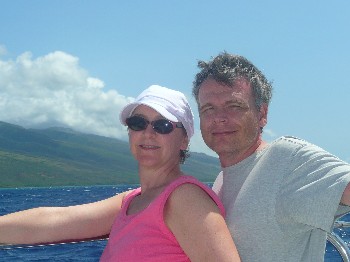
Rugged sailors, handsome couple.
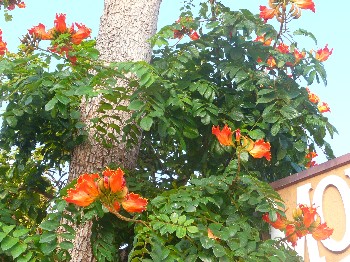
Flowers of Hawaii.
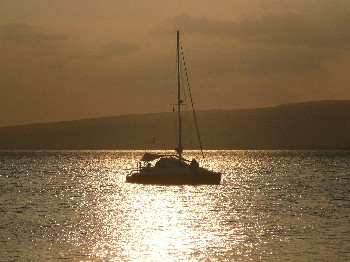
Light Wave resting.

Sushi night!
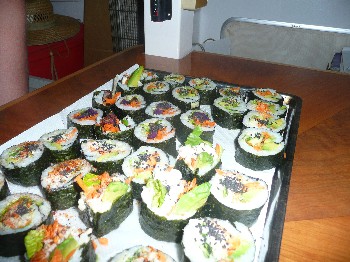
Wow! What a platter!
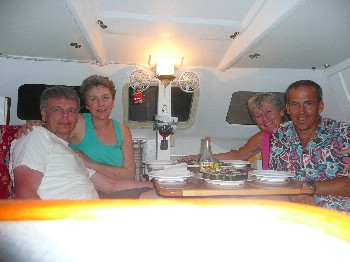
Happy sailors about to dive into some sushi.
Monday April 28, 2008
Garett: We all woke up at 5 a.m. and were off at 6 for the 10 mile crossing to Lana’i. When Carllie and I crossed this channel a week ago it was very rough and wet. This trip lived up to its billing with great sailing including one really big wave that completely soaked Casey and Amandah.
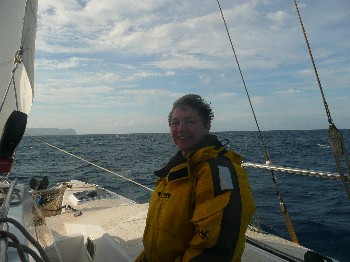
Amandah trying to dry off.

Casey air drying
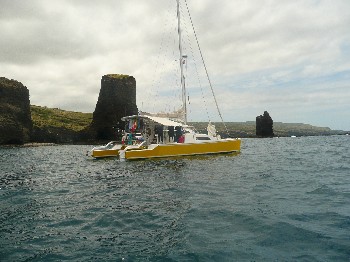
Carllie: On the west side of Lana’i, we stopped
at Nanahoa (the five pinnacles) Garett,
Amandah and I snorkled while Casey
stayed on the boat out of the sun. The snorkeling
was the best we had ever experienced, with beautiful
multi-colored coral and more colorful tropical fish
than we had ever seen before.
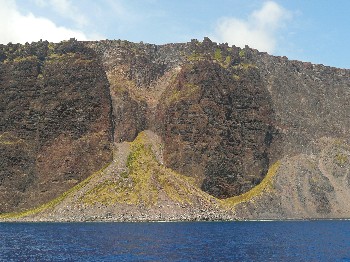
The cliffs on the west side of Lana’i.
As we came around the south end of Lana’i we decided to head into Manele Harbor to anchor for the night. We set one anchor and tied to the shore in two places off the breakwater in this compact harbor. As we settled down for the evening we heard that there were going to be 8 to 10 foot swells from the south developing overnight so we put out another anchor. There was still some light left so we decided to go on the short walk over to the beach to swim and body surf.
Back in Mexico a year ago I bought a body board but had never used it. The waves at Hulopo’e Beach were "only" 3 to 4 feet. Wow was that fun! We will have to come back tomorrow for some bigger waves.

Our first attempt at body boarding
and body surfing.
Note Carllie as a small ball in the surf.
on the right
Tuesday April 29, 2008
Garett: Before heading to the beach we took the bus from the swanky Four Seasons Hotel (rooms starting at $300 per night) to Lana’i City.
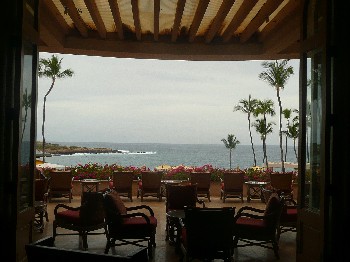
View from the Four Seasons Hotel.
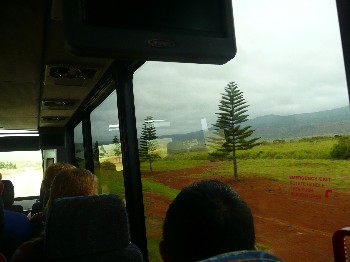
On the bus to Lana’i City
in the interior of the island.
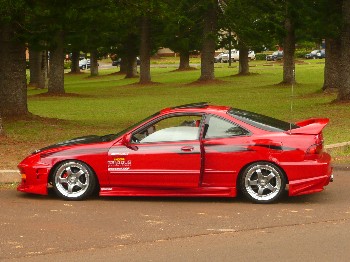
Very fancy car for only 15 miles of paved roads.
The young guys here enjoy their cars, just as
they do anywhere else.
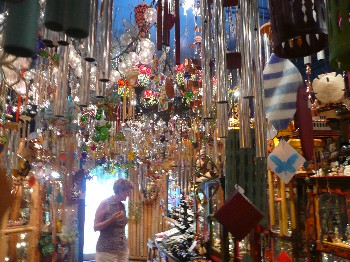
A gift shop full of chimes and crystals.
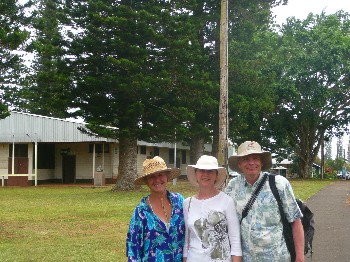
Tourists walk the few streets
of Lana’i City.

Garett: I lent Casey some of my
designer pants to keep the
sun off his sunburned legs
Quite a fashion statement.

Watching the surf between Hulopo’e Beach and
Manele Harbor.
Wednesday April 30, 2008
The entrance to the harbor was still to rough with big swells breaking right across so we decided to stay another day. Carllie made up some great sandwiches and so we headed off to the beach for a picnic lunch and to play in the water and the 8-foot waves.

This is a close up of one of the small ghost crabs
that guarding their holes that kept us
entertained during lunch.
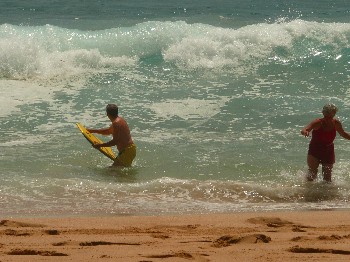
Do we go for it, or do we run?
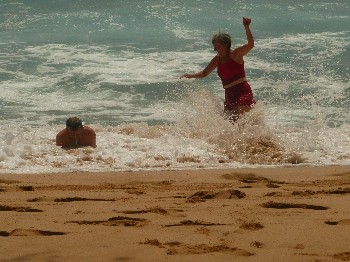
Garett boogie boards in, while
Carllie succumbs to the pull of
the outgoing surf on her ankles.
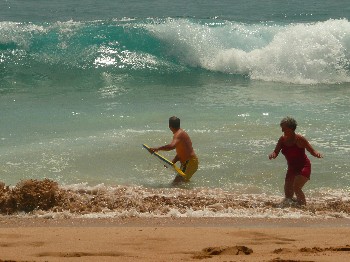
Yaaaaaaagggh!

Garett gets ready to boogie board,
while Carllie gets ready to body surf.
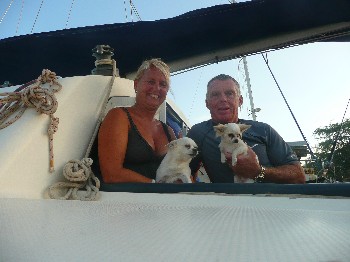
Our new friends Kim (Bikini Kim) and Scott Brown
who were tied up next to us in the harbor.
They have a few swim wear shops in the Maui area.
\